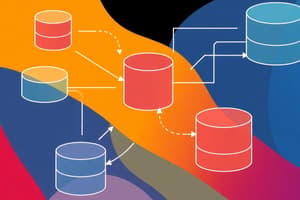Podcast
Questions and Answers
What is the primary role of database designers before the database is implemented?
What is the primary role of database designers before the database is implemented?
- To test and debug database applications.
- To communicate with prospective users to understand their requirements. (correct)
- To populate the database with initial data.
- To develop software applications for database interaction.
Which group primarily determines the requirements of end users?
Which group primarily determines the requirements of end users?
- Database designers
- End users themselves
- Database administrators
- System analysts and application programmers (correct)
What is an entity in the context of databases?
What is an entity in the context of databases?
- A user-defined function to manipulate data.
- A unique identifier for records in a database.
- A set of operations performed on stored data.
- A collection of attributes representing a real-world object. (correct)
What characterizes an attribute in a database?
What characterizes an attribute in a database?
What does a file contain in a database context?
What does a file contain in a database context?
Which role involves testing, debugging, and maintaining application programs connected to databases?
Which role involves testing, debugging, and maintaining application programs connected to databases?
What is a record in database terminology?
What is a record in database terminology?
Which of the following best defines 'end users' in a database system?
Which of the following best defines 'end users' in a database system?
What is the role of metadata in a database system?
What is the role of metadata in a database system?
What is the primary role of a Database Management System (DBMS)?
What is the primary role of a Database Management System (DBMS)?
Which of the following best describes the function of a DBMS concerning data sharing?
Which of the following best describes the function of a DBMS concerning data sharing?
Which of these is NOT a characteristic of the database approach?
Which of these is NOT a characteristic of the database approach?
How does a DBMS present data to end users?
How does a DBMS present data to end users?
Which advantage of using a Database Management System (DBMS) helps in protecting data from being accessed by unauthorized users?
Which advantage of using a Database Management System (DBMS) helps in protecting data from being accessed by unauthorized users?
In terms of data management, what does a DBMS help to hide from application programs and users?
In terms of data management, what does a DBMS help to hide from application programs and users?
What is the main responsibility of a Database Administrator (DBA)?
What is the main responsibility of a Database Administrator (DBA)?
What does a DBMS translate from application requests into?
What does a DBMS translate from application requests into?
How does a database ensure data abstraction?
How does a database ensure data abstraction?
Which factor is essential for data to be classified as information within a database?
Which factor is essential for data to be classified as information within a database?
What role do database designers play in the management of a database?
What role do database designers play in the management of a database?
Which of the following is not considered a role of the DBMS?
Which of the following is not considered a role of the DBMS?
Which of the following describes the 'sharing of data' characteristic in a database approach?
Which of the following describes the 'sharing of data' characteristic in a database approach?
Which of the following functions does a DBMS NOT typically provide?
Which of the following functions does a DBMS NOT typically provide?
In what way does a DBMS manage data structure?
In what way does a DBMS manage data structure?
Study Notes
Database Fundamentals
- A database consists of logically related data, including entities, attributes, and relationships, reflecting an organization's information.
- Data descriptor, known as metadata or a data dictionary, enables program-data independence.
Characteristics of Database Approach
- Self-describing nature signifies that databases hold both data and their descriptions.
- Programs and data are insulated, promoting data abstraction.
- Supports various views of the data, catering to different user needs.
- Facilitates multiuser transaction processing and data sharing.
Advantages of Database Management Systems (DBMS)
- Controls data redundancy, ensuring efficiency.
- Restricts unauthorized access to enhance security.
- Provides mechanisms for backup and recovery.
- Promotes data abstraction and independence.
- Offers multiple views for different users, improving accessibility.
Key Roles in Database Management
-
Database Administrators (DBA)
- Authorize and monitor access to the database.
- Accountable for system security and performance issues.
-
Database Designers
- Identify data to be stored and choose appropriate structures for representation.
Data vs. Information
- Data refers to unprocessed facts (e.g., raw numbers).
- Information is processed data that is accurate, relevant, and timely for decision-making.
Database Definition
- A database is a logically organized collection of related data, functioning as a central repository for various applications.
Database Management System (DBMS)
- A collection of programs managing database structures and controlling data access.
- Acts as an intermediary between users and databases, enabling data sharing and integration.
File System Development Levels
- Development evolves through manual approaches, traditional file-based methods, and finally into structured databases.
Key User Roles
-
End Users
- Access databases for querying, updating, and reporting tasks.
-
System Analysts and Application Programmers
- Analyze end-user requirements and develop database transaction specifications.
Basic Database Terminologies
-
Enterprise
- Refers to any organization (e.g., library, bank, university).
-
Entity
- A person, place, thing, or event of interest (e.g., student).
-
Attribute (Field)
- Specific data characteristic (e.g., name, age, phone number).
-
Record
- A collection of logically connected attributes describing an entity.
-
File
- A compilation of related records, such as customer data or student information.
Studying That Suits You
Use AI to generate personalized quizzes and flashcards to suit your learning preferences.
Related Documents
Description
This quiz explores the fundamental concepts of databases, focusing on the logical relations among data objects, entities, and attributes. It also highlights the importance of metadata for data independence and the structured approach of a database system in managing organizational information.




